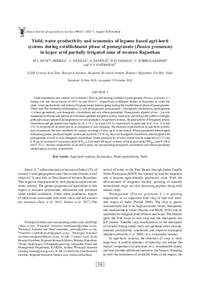Yield, water productivity and economics of legume based agri-horti systems during establishment phase of pomegranate (Punica granatum) in hyper arid partially irrigated zone of western Rajasthan

Authors:
Field experiment was carried out at farmer’s field in pre-bearing orchard of pomegranate (Punica granatum L.) during rabi and kharif season of 2015-16 and 2016-17, respectively in Bikaner district of Rajasthan to study the yield, water productivity and return of legume based intercropping during the establishment phase of pomegranate. There were five treatment combinations, i.e sole pomegranate, pomegranate + (fenugreek–clusterbean), pomegranate + (wheat-groundnut), sole fenugreek –clusterbean and sole wheat-groundnut. Pomegranate planted at 4m × 3m was maintained with drip and intercrops with mini-sprinkler irrigation system. Intercrops showed positive effect on height, girth and canopy spread of pomegranate over sole plantation. In agri-horti systems, the productivity of fenugreek, wheat, clusterbean and groundnut were higher by 20.5, 15.1, 16.4 and 14.9 %, respectively in grain and 18.0, 15.0, 31.6 and 12.4 %, respectively in straw/stover, as compared to sole cropping. the increase in productivity in agri-horti systems may compensate the area sacrificed by canopy coverage of trees up to some extent. Wheat-groundnut intercropped with pomegranate produced higher system productivity (5376 kg /ha) over fenugreek-clusterbean intercropped with pomegranate as well as sole fenugreek-clusterbean. Water productivity of sole orchard can be improved to 0.21 and 0.39 kg /m3 in terms of economic yield (WPeY), 0.64 and 0.99 kg/m3 in terms of biological yield (WPBY) and ` 108.8 and ` 151.1 /ha/mm, respectively in monitory terms by incorporating fenugreek–clusterbean and wheat-groundnut intercropping systems, respectively.
